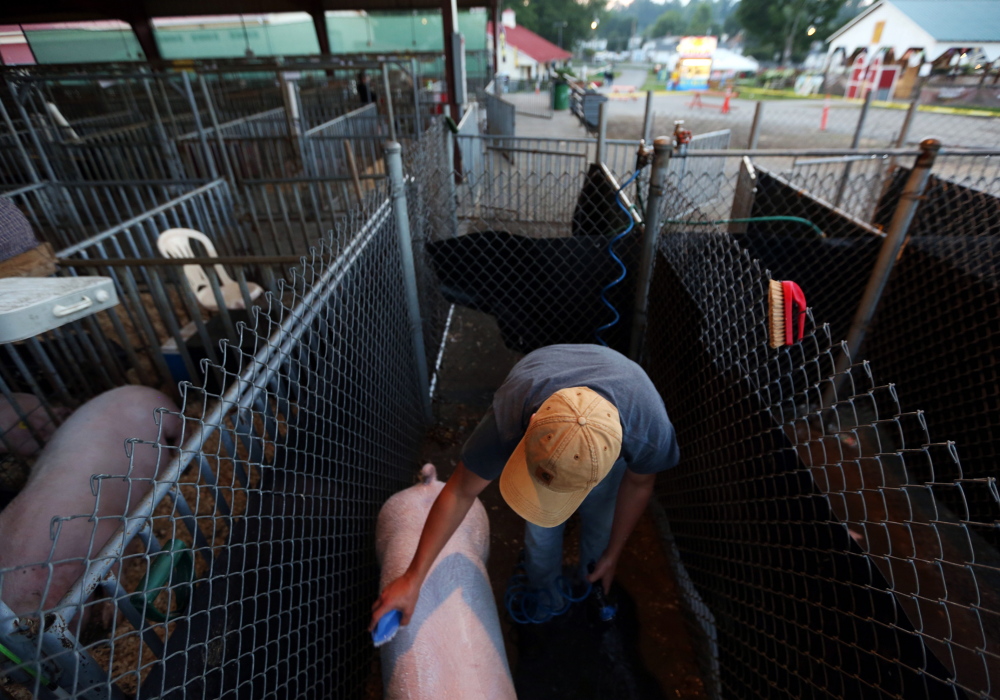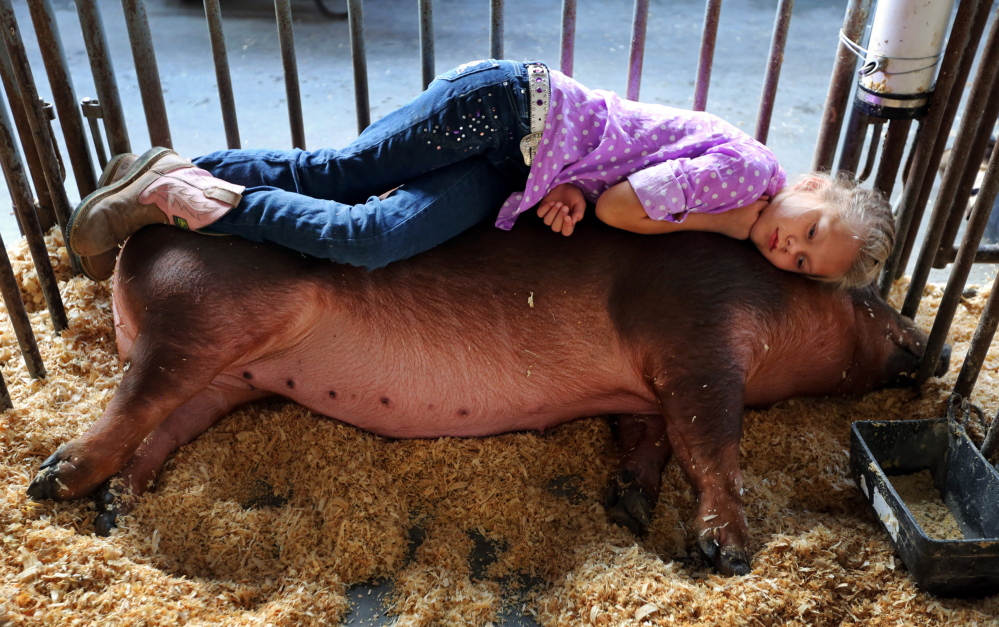Tiffany LaRue, 17, had not been lucky with her pigs this year. One had its placenta detach, killing the embryos. Another was supposed to have been pregnant when they bought her but wasn’t. Another, LaRue said, just simply didn’t take.
That left LaRue with one option if she wanted to show a pig at the West Virginia State Fair: Buy one from the pig farm down the road. “By that time, it was so late that all we could get were these,” she said, pointing at two hogs sleeping on shavings. One russet brown and one black – Fire and Brimstone, she named them.
Still, LaRue and her younger brother Levi took care of their hogs as they’d been taught how in 4-H and Future Farmers of America, walking them every day to build muscle, bathing and carefully measuring their feed. But she knew they were doomed to lose, when other kids could scour the country for the best pigs money could buy.
“They go out of state, and have all this money to spend on a pig, so that they’ll win,” LaRue explained. “And they buy them already muscled, so you go out and take them in the ring, and the pig already knows what to do. So all these family-run farms, we have to breed our own, and we try to breed for the muscle, but you can’t always do that because you have accidents.” Like sows failing to have litters, for example.
“We can’t do nothing because nobody’s going to do anything about it,” agreed Cody Taylor, another youngster who’d bred his sow with a Yorkshire boar to get the blue-specked porker in his pen. “But it’s gonna come back and get ’em. One of these little farm pigs is gonna beat them and become grand champion.”
“One can hope,” LaRue rolled her eyes. “One CAN hope,” Taylor replied staunchly.
THE NATURE OF THE BEAST
The kids’ frustration isn’t just the underdog’s lament – it also reveals a lot about how farming has changed, and junior livestock competitions along with it. The family farm of the American imagination has all the animals one might want to eat. In the days of small-scale agriculture, farm kids would take their best sheep, pig, goat or heifer to the fair as their FFA or 4-H project. The competition was about animal husbandry, end-to-end, and the most skilled kid could win.
That’s no longer the case. Fewer kids grow up on farms, and those that do are much more specialized – the number of hog operations fell by 70 percent between 1992 and 2009, for example, while production increased. That means more have to buy half-grown animals to show in livestock competitions, fueling the growth of specialized breeders and pushing up the cost of participation. In the end, those with disposable income can buy a good chance at a ribbon – and those who can’t might just be stuck with the scraps.
LaRue and Taylor’s competition is across the aisle: Trixie and Paisley, a Hampshire cross and an exotic, their hindquarters bulging, their coats gleaming. Their owners, the Vaughan family, are not professional farmers; father Danny Vaughan outfits banks with money-processing technology. For recreation, they own a stable full of show cattle, which Ryan, 12, and Garrett, 14, exhibit around the country. Their pigs have won a few times before – Ryan’s name hangs on a banner in the fairgrounds’ agricultural building, as Erica Vaughan notes with pride.
“It’s a bloodbath in the barn,” says Erica, who wears a sweatshirt with a rhinestoned pig on it as she putters around the pig stalls, sweeping up shavings and sifting out their poop. “We were talking last night, and I said ‘Ryan, they’re coming after you, honey.’ ”
Show season is intense in the Vaughan household. The pigs get two baths per day, Erica says, and take long walks. They livestream the Midwestern state fairs to monitor the latest trends, and follow their judge-to-be on Facebook. They feed just the right amount so that their pigs achieve their perfect weight as the day of the show arrives.
“You want to dial it in, you want it at 12 o’clock, you want it ready to go,” as Erica puts it.
The Vaughans got their pigs in May, one from a breeder called McCoy Genetics in Ohio (slogan: “Continually making them better”), and another from Travis Platt in Indiana (“Fill space in your trophy case with Platt Showpigs”).One of them sold through Showpig.com, the premier online auction site, which has doubled the number of auctions it does over the past six years and in 2013 recorded an average sale price of $963, up from $550 in 2013 dollars five years ago, though prices can get as high as $8,000.
Increasing sale prices are just one component of the escalating cost of showing pigs – premium feeds are also very expensive. But they’re not as costly as cattle, which is partly why interest has grown in hog competitions. The National Swine Federation recorded a 15 percent increase in the number of purebred registered hogs between 2009 and 2013, and youth membership tripled over the past 10 years, to 12,400 kids.
Vaughan declined to say how much she paid for their pigs. “We do the top line of everything,” she says. “You get out of it what you put into it.”
Success in the show ring, however, is a far from objective process – especially when the judges themselves are in the hog breeding business.
“There is a lot of politics to it,” Vaughan says. “There’s people we’ve never bought a pig from, and they’ll bring them right to the top, and kick ’em in the guts. And they’re doing that to my little boy, that makes my mommy claws come out a little bit. I’ll never go to a sale of his, if that’s how you’re going to treat me. You should be saying, ‘I want you to have my pig.’ ”
‘A WHOLE OTHER MARKET’
The Vaughans’ determination aside, competition in West Virginia is mild compared to the massive state fairs in Iowa and Indiana and Ohio. Farms are smaller in the East, and the local food movement is stronger. The Midwestern shows are more heavily influenced by industrialized agriculture; hundreds of pigs participate, and the payoff from winning is potentially huge.
“It’s amazing, it’s a whole other market to itself,” says Jason Hughes, West Virginia University’s career and technical education coordinator and the state’s FFA adviser. “They’re showing most of the year, and they’re spending much bigger dollars than we can even fathom.”
Still, coal country takes cues from its neighbors to the West. The livestock market has become more uniform across states, both through national online auctions, as well as sales of semen, which let smaller breeders access elite gene pools without spending tens of thousands of dollars on a boar of their own.
Sometimes, the trade in show animals goes both ways: Breeders of one kind of animal will buy another kind of animal for their kids to exhibit. Take Eddie Riggleman, who bought a goat and a pig from out of state for his stepdaughter Ashley to show. He’s in the same business as the producers he supports, breeding and selling show lambs for an average of $1,500 each – though some run as high as $4,000, especially in the online sales. High-income buyers, he says, don’t always respond to price.
“Doctors, lawyers, all that matters is that they get satisfied,” Riggleman says. “It’s my livelihood. As long as I can get it, I’m going to get as much as I can.”
MAY THE BEST PIG WIN
The morning of the market hog show dawned wet and gray. Ribbons fluttered from the hog pens from the previous night’s showmanship competition – the part where kids are judged on how well they control their pigs as they run around an arena with other pigs – and Tiffany is back in her FFA jacket and slacks. Hogs careen around the aisles as their owners attempt to shepherd them into the ring, where a judge quickly ranked them and explained his reasoning. This one didn’t appear “fresh and youthful” enough, that one “lacked definition and soundness.”
When her lightweight class was called, Tiffany prodded the brown pig onto her feet. She knew she didn’t have much of a chance – animals bred for human consumption don’t necessarily look like the ones a judge will pick out of a lineup. Though ostensibly rooted in what makes a meat pig marketable, decisions often come down to the nebulous quality of “eye appeal.”
“The breeding for production has diverged from what you’re looking for in a successful show animal,” says Kevin Shaffer, a livestock production specialist at West Virginia University’s Extension Service, who also serves as the state’s 4-H adviser. “They can tell what kind of meat a hog will produce from ultrasounds and blood tests. What it looks like doesn’t matter quite as much. If they’re a production-end product-oriented farm, they could very well be at a disadvantage from the show standpoint.”
Sure enough, Fire and Brimstone placed dead last in their classes, as did Cody Taylor’s entry. Ryan Vaughan’s Trixie finished second in the middle-weight category, but Garrett’s pig showed sluggishly and didn’t place, which Erica Vaughan attributed to having to sit for days on concrete with little exercise.
The pig that walked away with the trophy belonged to the Bartenslagers, who are in the show cattle business, and keep a barn full of other animals that the kids take to other competitions. They bought a blue butt from a breeder in Pennsylvania for $500. The most expensive pig doesn’t always win – a champion, says patriarch Art Bartenslager, is a combination of good genes, the judge’s particular taste, and absolute dedication to the art of animal management. Kids who resent losing, he says, just might not be working hard enough.
Send questions/comments to the editors.




Success. Please wait for the page to reload. If the page does not reload within 5 seconds, please refresh the page.
Enter your email and password to access comments.
Hi, to comment on stories you must . This profile is in addition to your subscription and website login.
Already have a commenting profile? .
Invalid username/password.
Please check your email to confirm and complete your registration.
Only subscribers are eligible to post comments. Please subscribe or login first for digital access. Here’s why.
Use the form below to reset your password. When you've submitted your account email, we will send an email with a reset code.